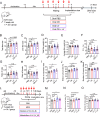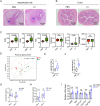Maternal intestinal L. vaginalis facilitates embryo implantation and survival through enhancing uterine receptivity in sows
- PMID: 40533850
- PMCID: PMC12175382
- DOI: 10.1186/s40168-025-02141-7
Maternal intestinal L. vaginalis facilitates embryo implantation and survival through enhancing uterine receptivity in sows
Abstract
Background: The embryo implantation quality during early pregnancy is the predominant factor for embryo survival and litter performance in sows. Gut microbiota is demonstrated to show a correlation to pregnancy outcomes by participating in regulating maternal metabolism. However, the specific functional microbiota and its mechanical effects on regulating embryo implantation and survival remain unclear. The objective of this study was to clarify whether embryo implantation and litter performance were affected by maternal intestinal microbiota, and to identify specific microbial communities and its mechanism in regulating embryo implantation.
Results: In this study, we first conducted 16S rRNA sequencing and metabolomic analysis revealing the intestinal microbiota and metabolism of 42 sows with different litter size to select the potential functional microbiota that may contribute to embryo survival. Then, we explored the effects of that microbiota on embryo implantation and litter performance through microbiota transplantation in mice and sows. We found that maternal intestinal L. vaginalis exhibits enrichment in sows with higher litter size, which could facilitate embryo implantation and survival and ultimately increases litter size in mice. We further employed transcriptomic analysis to determine the characteristics of uterus, which found an enhanced uterine receptivity after L. vaginalis gavage. The plasma untargeted metabolomic analysis after L. vaginalis gavage in mice and targeted metabolomics analysis of in vitro cultured medium of L. vaginalis were used to evaluate the metabolic regulation of L. vaginalis and to reveal the underlying functional metabolites. Next, an increasing adhesion rate of endometrial-embryonic cells and an obvious increasing formation of pinopodes in cell surface of porcine endometrial epithelial cells were observed after treatments of L. vaginalis metabolites, especially galangin and daidzein. Also, the gene expression levels related to uterine receptivity were increased after treatments of L. vaginalis metabolites in porcine endometrial epithelial cells. Finally, we found that L. vaginalis or its metabolites supplementation during early gestation significantly increased the litter performance in sows.
Conclusions: Overall, intestinal microbial-host interactions can occur during early pregnancy and may be contribute to maternal metabolic changes and influence pregnancy outcomes in mammals. Our study provides insights of maternal intestinal L. vaginalis to enhance uterine receptivity and to benefit embryo/fetal survival through a gut-uterus axis, contributing to advanced concept and novel strategy to manipulate gut microbiota during early pregnancy, and in turn to improve embryo implantation and reduce embryo loss in sows. Video Abstract.
Keywords: L. vaginalis; Embryo implantation; Litter performance; Sows; Uterine receptivity.
© 2025. The Author(s).
Conflict of interest statement
Declarations. Ethics approval and consent to participate: All experiments were conducted with the approval of the Institutional Animal Care and Use Committee of Huazhong Agricultural University (Approval number: 202311010004 and 202401210006), in accordance with the governmental regulations of China. Consent for publication: Not applicable. Competing interests: The authors declare no competing interests.
Figures








Similar articles
-
Integrated multi-omics analysis reveals the functional signature of microbes and metabolomics in pre-diabetes individuals.Microbiol Spectr. 2025 Jul;13(7):e0145924. doi: 10.1128/spectrum.01459-24. Epub 2025 Jun 9. Microbiol Spectr. 2025. PMID: 40488467 Free PMC article.
-
Shoutai pill exhibits anti-miscarriage efficacy through tripartite modulation of gut microbiota, systemic metabolism, and maternal-fetal immunity: A multi-omics analysis.Phytomedicine. 2025 Sep;145:156991. doi: 10.1016/j.phymed.2025.156991. Epub 2025 Jun 19. Phytomedicine. 2025. PMID: 40582211
-
Gut microbiota regulates the brain metabolism of sexually mature drones.Microbiol Spectr. 2025 Jul;13(7):e0253624. doi: 10.1128/spectrum.02536-24. Epub 2025 Jun 5. Microbiol Spectr. 2025. PMID: 40470936 Free PMC article.
-
Pharmacological and electronic cigarette interventions for smoking cessation in adults: component network meta-analyses.Cochrane Database Syst Rev. 2023 Sep 12;9(9):CD015226. doi: 10.1002/14651858.CD015226.pub2. Cochrane Database Syst Rev. 2023. PMID: 37696529 Free PMC article.
-
Arginine for gestating sows and foetal development: A systematic review.J Anim Physiol Anim Nutr (Berl). 2018 Feb;102(1):204-213. doi: 10.1111/jpn.12679. Epub 2017 Mar 6. J Anim Physiol Anim Nutr (Berl). 2018. PMID: 28263002
References
-
- Ogawa S, Takahashi H, Satoh M. Genetic parameter estimation for pork production and litter performance traits of Landrace, Large White, and Duroc pigs in Japan. J Anim Breed Genet. 2023;140:607–23. - PubMed
-
- Kimura I, Miyamoto J, Ohue-Kitano R, Watanabe K, Yamada T, Onuki M, Aoki R, Isobe Y, Kashihara D, Inoue D, et al. Maternal gut microbiota in pregnancy influences offspring metabolic phenotype in mice. Science. 2020;367:eaaw8429. - PubMed
-
- Ye Q, Zeng X, Cai S, Qiao S, Zeng X. Mechanisms of lipid metabolism in uterine receptivity and embryo development. Trends Endocrinol Metab. 2021;32:1015–30. - PubMed
-
- Norwitz ER, Schust DJ, Fisher SJ. Implantation and the survival of early pregnancy. N Engl J Med. 2001;345:1400–8. - PubMed
MeSH terms
Substances
Grants and funding
- 32202700/National Natural Science Foundation of China
- 31925037/National Natural Science Foundation of China
- 2022YFD1300405/National Key Research and Development Program of China
- 2022YFD1300405/National Key Research and Development Program of China
- 2022YFD1300405/National Key Research and Development Program of China
LinkOut - more resources
Full Text Sources

